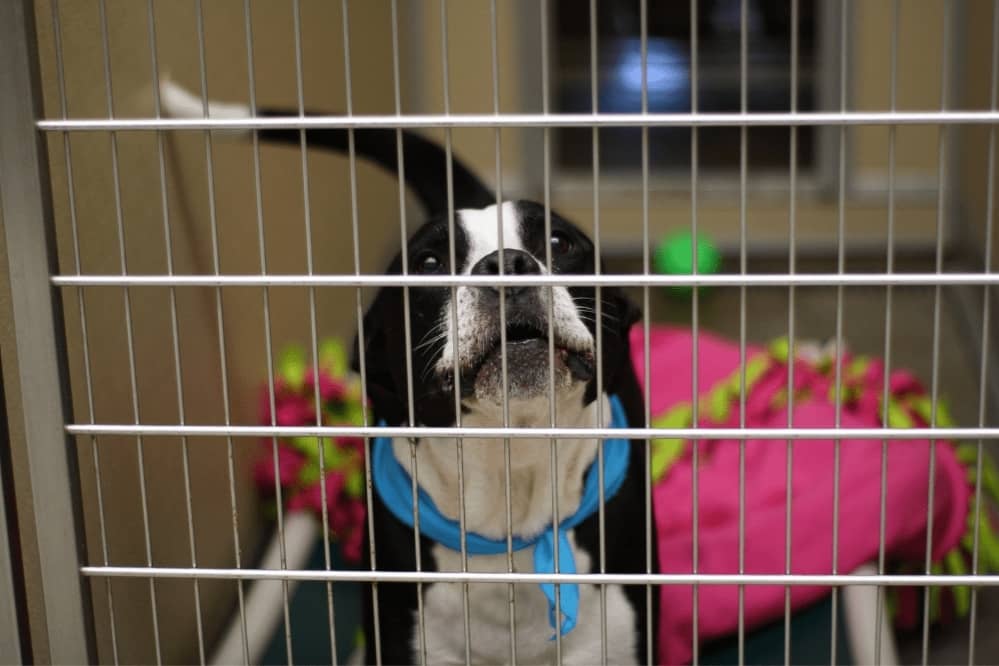Crate training a dog is very useful for many different reasons, but that said, it’s not always an easy thing to accomplish. Getting your dog to like the crate, to feel comfortable inside of it, and even to stay there and feel OK when you leave the home (with the crate door closed) is often quite the challenge.
You might be wondering how long it is going to take to crate train your dog. If you follow a good crate training routine, it should not take longer than a few weeks to accomplish.
However, that said, this all really depends on the dog in question as well as your efforts. Young dogs and even puppies usually are not too hard to crate train, but older dogs set in their routines or adopted dogs (such as from a shelter) may present a much bigger challenge.
Some dogs might be crate trained within a couple of weeks whereas others may take months. Let’s go over the best steps and tips for crate training your dog as fast as humanly possible.
Best Dog Crates of 2022 Complete Reviews with Comparisons
Step 1: Introducing the Crate – 2 to 7 Days
The first step in this process is to get your dog accustomed to the crate, so it feels comfortable being around and inside of the crate. Take the crate, take the lid off of it, put a soft towel or blanket inside of it, and put it in an area where the family spends a lot of time. You want this first step to take place in the room where you spend the most time.
If your dog is naturally curious, it might sniff around and explore the crate all on its own. If your dog is not naturally curious in this way, or if it seems weary of the crate, there are a few things that you can do to try and encourage the dog to check the create out. This process may take as little as 2 days or as long as a full week.
- Start by trying to bring the crate close to the dog, just so it can see it, and be sure to talk in a happy and calm tone of voice, just to reassure the dog. Make sure all parts of the crate are secure, so for example, secure the door so it cannot move and frighten your dog.
- Start by placing some of your dog’s favorite treats and toys near the crate. Keep moving the treats and toys closer to the crate, and then move onto the next step.
- Throw some treats into the crate. Dogs are naturally attracted to foods, especially really tasty treats. Keep throwing treats into the crate, until your dog can no longer resist.
- If treats do not work, another idea is to do the same thing as with the treats, but with some of your dog’s favorite toys.
Step 2: Feeding & The Crate – 4 to 14 Days
Once your dog feels fairly comfortable being near the crate and inside of it, it’s time to start creating a super pleasant association with the crate, and with dogs, this is best done through food. Feeding your dog inside of the crate will reinforce happy thoughts and a positive association.
- Start with the lid off the crate and the door open. Place the dog’s meal outside of the crate. Let the dog eat near the crate for a couple of days.
- Now it is time to move the meal inside of the crate for feeding time. If your dog seems reluctant to enter the crate, place the meal at the front, right by the door, and keep moving it further in with every feeding. If the dog seems to feel comfortable entering the crate, place the meal at the rear of the crate. Do this for 2 or 3 days.
- When the dog feels comfortable eating inside of the crate, trying upping the ante by putting the lid back on the crate and closing the door during feedings. Open the door the very second the dog is done its meal. Each time you do this, leave the door closed for a couple minutes longer after the dog is done eating, until you reach about 10 minutes after feeding with the door closed. This step might take up to a full week to accomplish, if not a little longer.
- If your dog seems to feel uncomfortable, you may have left it in the crate for too long after the meal without opening the door. You increased the intervals too quickly. If your dog whines, do not let them out until they stop. If you let the dog out when it whines, you are actually encouraging them to whine, because they know you will let them out.
Step 3: Increasing Time Spent in the Crate – 7 to 14 Days
Now that your dog is used to eating its meals inside of the crate, it’s time to crate your dog outside of mealtime, but still with you being home. This will help get the dog accustomed to the crate even when it is not mealtime.
- Get them to come to the crate and give them a treat. Remember that this is all about creating a positive association with the crate.
- Try teaching them a command to enter the crate, one such as “kennel” or “crate”. Point inside of the crate with a treat in hand. This should encourage them to enter the crate.
- Once your dog enters the crate, praise them a lot, give them the treat, and close the door. Sit near the crate for 5 or 10 minutes with the door closed. Leave the room for a couple of minutes, return, sit near the crate for a few more minutes, and then let the dog out.
- Keep repeating this several times per day, and each time you do it, increase the amount of time you spend in the other room before coming back.
- If your dog behaves and sits quietly inside of the crate for about 30 minutes while you are in the other room, then this step has been completed.
Step 4: Crating the Dog when You Leave – 1 Week or More
The final step, now that your dog feels comfortable being inside of the crate alone for 30 minutes, is to leave the dog alone for short periods of time. In other words, here is when you leave the house.
- Using the command and treat procedure, get the dog in the crate and close the door. You should also leave its favorite bed/blanket, a couple of treats, and a couple of toys.
- Crate your dog about 10 to 20 minutes before you leave. Don’t put it in the crate and leave right away.
- Make sure that when you leave, you don’t coddle the dog or make it an emotional event. Just leave. The same goes for when you come back. This should not be emotionally charged. Start off by leaving for half an hour, then when you get back, let the dog out a few minutes after you return, not right away. Also, when you let the dog out, give it a treat and some praise.
- In the beginning, try to do this several times per day, 30 minutes each time. Then, day by day, increase the amount of time you leave the home.
Conclusion
If you have a calm and collected dog, plus a bit of luck on your side, you may be able to complete this crate training process in as little as 2 or 3 weeks. However, if it is taking longer, don’t lose your patience. It might take a couple of months, but it will work eventually. Never get frustrated or try to rush this process, as your own frustration will be picked up by the dog and just make it worse.

